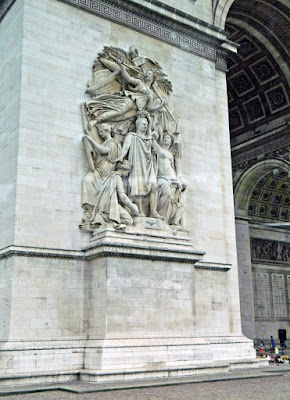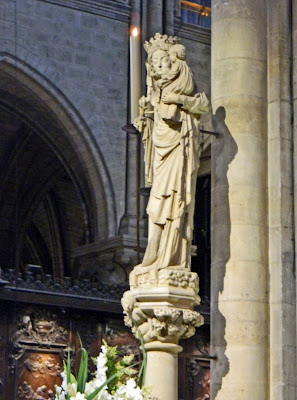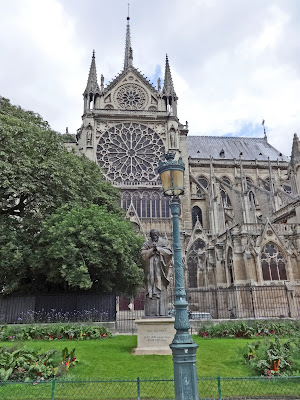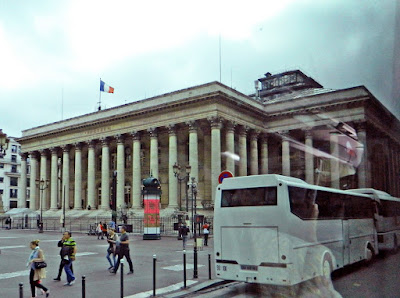I tell myself not to take photos from a bus, but always do it anyway...
The Viking River Cruises excursion for today was a tour of Paris, by bus; excusez moi, by motor coach! The Viking passengers were divided into groups denoted by letter, and boarded one of the five buses with the same letter. Each bus had a driver (yes!) and a guide.
We left Le Pecq by crossing the River Seine and traveled through the wealthy western Paris suburb of Le Vésinet with its mansions and fancy gas station with a thatched roof. Josephine Baker lived here (circa the 1930s) with her pet cheetah.
Next through Chatou, crossing the Seine again with an island where Auguste Renoir painted Déjeuner des canotiers/Luncheon of the Boating Party (1880-1881). After passing through Nanterre, we were in the business district called La Défense, where they have built modern skyscrapers.
 |
| La Défense skyscrapers; Left: [Connected] Tours/Towers Pascal A and B (1983); Right: Tour Voltaire (1988), both by architect Henri la Fonta |
 |
| La Défense skyscrapers; Left: Tour/Tower Majunga (2011-2014) by architect Jean-Paul Viguier; Right: [Rounded top] Tour D2 (2011-2014) by Anthony Béchu and Tom Sheehan |
 |
| La Grande Arche (1989) designed by the Danish architect Johann Otto von Spreckelsen and engineer Erik Reitzel |
The Grand Arch is also on a line with the Eiffel Tower and the Montparnesse Tower, the first skyscraper in Paris built 1969-1973, which led to a ban on buildings more than seven stories high in the city center.
Our bus circled l'Arc de Triomphe one-and-a-half times (on purpose; I can see that some drivers could get stuck in the whirlpool of traffic! There are no lane markings and you could have 6-7 cars abreast circling the arch).
 |
| Triumph of Napoléon by J P Cortot shows Paris kneeling at the feet of a Caesar-like Napoléon |
Now the bus drove down Avenue des Champs-Élysées/Elysian Fields Avenue, the "most beautiful avenue in the world." The south side of the street is more chic than the north, which in itself is pretty chic.
 |
| McDonald's at #140, now the largest McDonald's in the world |
 |
| Champs-Élysées ends at Place de la Concorde |
 |
| Maxim's on Rue Royale, the most glamorous bistro in Paris from about 1900-1970, with carved wood exterior |
 |
| Maxim's has Minim's next door |
 |
| La Madeleine (1794-1845), a church redesigned by Pierre Vignon for Napoléon as Temple de la Gloire de la Grande Armée |
 |
| Military presence in Paris |
 |
| Printemps, a major department store, on Boulevard Haussmann |
 |
| La Palais Garnier/L'Opéra National de Paris (1861-1875) designed by Charles Garnier in 2nd Empire Beaux-Arts style for Napoléon III; famous as the setting for The Phantom of the Opera |
 |
| Figure groups: Left: Dance by Jean-Baptiste Carpeaux (criticized as indecent) and Right: Lyric Drama by Jean-Joseph Perraud |
 |
| Galeries Lafayette, another major department store on Boulevard Haussmann |
 |
| Removable stanchions |
 |
| Hôtel de Ville/City Hall (19C reconstruction of 1533-1628 building after an 1871 fire, in neo-Renaissance style); the Gay Pride parade was yesterday (KSS) |
 |
| River Seine where the floodwaters of early June 2016 reached the level of the horizontal red hose on the embankment wall to the right in the photo (KSS) |
 |
| Rental bicycles (KSS) |
 |
| Architecture typical of the Second Empire style, under Napoléon III with Baron Haussmann |
 |
| Charlemagne et ses Leudes/Charlemagne and his guards (1878 or 1882) by brothers Louis and Charles Rochet; Charlemagne's reign marked the birth of France |
 |
| Cathédrale Notre Dame de Paris (1163-1345) |
 |
| Le Portail de la Vierge/Portal of the Virgin |
 |
| West rose window with a statue of Mary and two angels |
 |
| On the balcony of the north tower, a gargoyle props on his elbows |
 |
| Le Portail du Jugement/Portal of the Last Judgment, with the devil tipping the scales below the figure of Christ |
 |
| The chapels in the right aisle have become glass-enclosed confessionals; talk about transparency! |
 |
| Statue of Jeanne d'Arc/Joan of Arc in armor |
 |
| Painting of St Thomas Aquinas with students drinking at the fountain of knowledge; he studied and taught at the University of Paris |
 |
| North rose window, the only window with original medieval stained glass |
 |
| Virgin and Child (14C) transferred from La Chapelle St-Aignan in 1855; considered THE Notre Dame of Paris |
 |
| Carved choir screen (south) by Jean Ravy (KSS) |
 |
| Reliquary of Ste-Geneviève (c. 1850) by goldsmith Placide Poussielgue-Rusand, which is apparently a second reliquary after one that is housed in the church of St-Étienne du Mont |
 |
| Reliquary of Ste-Geneviève detail (KSS) |
 |
| Pietà (17c), by Nicolas Coustou, on gilded base by François Girardon, flanked by kneeling statues of Louis XIII and Louis XIV, the latter by Antoine Coysevox (KSS) |
 |
| Notre Dame spire, covered with the "flames" of the Holy Spirit, and a gargoyle |
 |
| Notre Dame spire (1860), added during the renovation inspired by the Victor Hugo 1831 novel The Hunchback of Notre Dame, which saved the cathedral from being demolished |
 |
| Statue of Le Pape Jean-Paul II/ Pope John Paul II (2011) by Russian-Georgian sculptor Zurab Tsereteli, dedicated in 2014 (KSS) |
 |
| Jean-Paul II in front of the south rose window of Notre Dame (KSS) |
 |
| Flying buttresses of Notre Dame with a bust of Carlo Goldoni (1907), an Italian playwright, by Eduardo Fortini (KSS) |
 |
| Pigeon posing on a gargoyle |
 |
| Notre Dame gargoyle |
 |
| Fountain of the Virgin (1845) sculpted by Louis-Parfait Merlieux, from a design of architect Alphonse Vigoureux, on the site of the Archbishop's Palace (17C) |
 |
| Spinning playground equipment |
 |
| Tourist boat on the Seine (KSS) |
 |
| Looking back at Notre Dame (KSS) |
Continue with Bus Tour of Paris II.




No comments:
Post a Comment